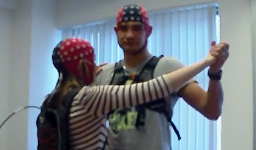Researchers from BTU Cottbus-Senftenberg and HS Zittau/Görlitz studied how dance partners communicate non-verbally and how empathy helps them anticipate each other’s next move. Using a novel EEG setup, they measured brain activity while couples danced in real-life conditions, not just in a lab. The work also led to new, potentially lower-cost sensor technology with applications like assistive devices and balance-support systems.
Prof. Dr. Dietmar Henrich, Tino Schmidt (BTU Cottbus- Senftenberg), Prof. Dr. Matthias Schmidt (HS Zittau / Görlitz) and their team of researchers have done a study on the communication processes that occur between dancing partners while dancing.
Rather than investigating the spoken words during the dance, they were focused on the non-verbal communication, specifically, the body language of the dancing couples and the role of empathy. How do the dance partners detect what their partner’s next step is and act upon it? This is most of the times an intuitive process which happens very naturally. While empathy is not only essential for a well-oiled dancing couple, it is a valued asset in discussions and negotiations, when spoken communication is not enough for a successful conversation.
Dancing is a good method to investigate consecutive movement changes and how they occur to be. To investigate the process of movements and the role of empathy, the researchers have used an innovative electroencephalography (EEG) system, novel in the market of neuroscience. While the couple was dancing to a simple rhythm, brain processing actions were studied in the brain. This method is a completely new territory, as EEG investigations were never before tested in real-life situations and activities. All neuroscience experiments were in the past done purely in labs. The transfer of these experiments to everyday situations is often doubtful. Many believe that by adding the word " neuro " they will gain scientific respectability. Terms like neuromarketing, neurotraining and neurolearning are very popular. “But unfortunately, many times misused, “according to Tino Schmidt of the BTU Cottbus.
The practical applications of this research results are very diverse. In the course of these experiments, a new sensor and measuring technology was developed. This way the expensive equipment could become affordable for smaller medical practices and applicable for many different settings in daily life. “Colleagues in California are investigating how to steer a wheelchair purely through the power of thought” said Professor Heinrich. Matthias Schmidt and Dietmar Henrich are investigating a shoe sole that measures and controls the balance by utilizing pressure sensors. In a later stadium this can be used for assistance of patients with balance disorders.
The research primarily focuses on the transfer of research to daily practice. How can we make the advantages of theoretical research available for people in everyday situations? The researchers from the Northwestern part of Germany are also collaborating with colleagues abroad. Professor Dietmar Henrich found partners in Palestine and Israel last year. Recently, he presented preliminary results of the Lausitz project at the ANT Neuro Meeting 2014 in Burgundy, France; followed by conferences in Vienna and Paris. Dietmar Henrich and Matthias Schmidt met at TU Dresden a few years ago when they were doing psychological experiments with magnetic resonance imaging (MTR). Professor Henrich is Professor and Dean of the Medical Technology in Senftenberg. Professor Schmidt teaches Organization and Communication Psychology at the University of Applied Sciences Zittau / Görlitz.
See the presentation with preliminary results as presented at the ANT Burgundy Neuromeeting 2014:
